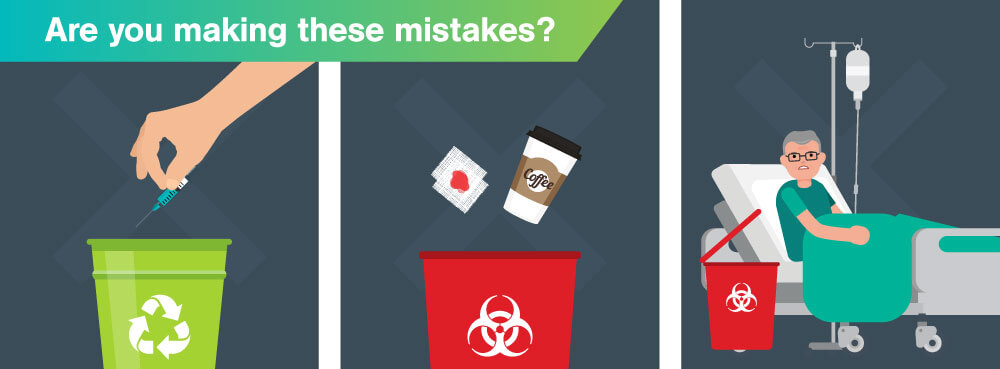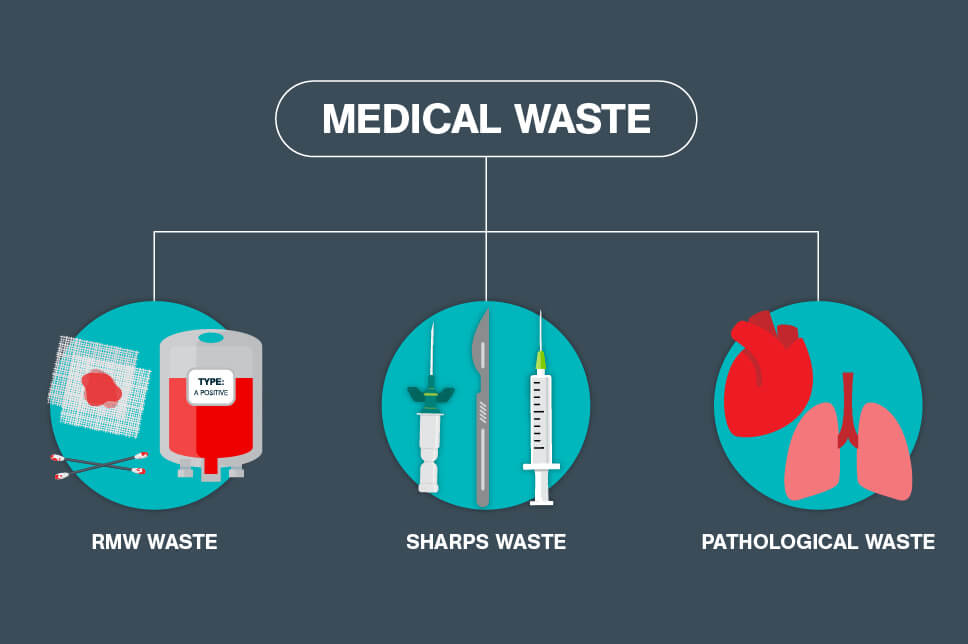Your Ally in Medical Waste Removal: Professional Service with Environmental Care
Wiki Article
Best Practices for Medical Waste Monitoring
Clinical waste administration is a crucial aspect of medical care facilities' procedures to guarantee the safety and security of clients, staff, and the atmosphere. Carrying out ideal techniques in clinical waste management is important to reduce the threats connected with harmful waste. This consists of appropriate partition and classification of waste, guaranteeing its secure storage and labeling, adhering to regulative standards, and using effective disposal techniques. By adhering to these ideal practices, health care centers can lower the possibility for infections, injuries, and air pollution triggered by incorrect handling and disposal of clinical waste. This introduction intends to give an overview of the value of best methods for medical waste administration and the succeeding areas will certainly explore each technique carefully - medical waste disposal service.
Segregation and Categorization
In the field of clinical waste administration, proper partition and classification are essential practices for ensuring the efficient and secure disposal of healthcare-related materials. Medical waste is generated from various resources, including medical facilities, centers, laboratories, and various other health care facilities. It includes a vast array of products, such as needles, syringes, bandages, gloves, and pharmaceutical waste.Partition entails the methodical splitting up of various kinds of clinical waste based on their characteristics and possible threats. Sharps waste, such as needles and blades, must be positioned in puncture-resistant containers to prevent injuries and the spread of contagious diseases.
Classification is the procedure of identifying clinical waste right into various classifications based upon its possible threats. These categories may include contagious waste, hazardous waste, pharmaceutical waste, and basic waste. By categorizing waste, health care centers can identify the appropriate disposal methods and guarantee conformity with local policies and standards.
Correct segregation and classification of medical waste not just shield the wellness and security of healthcare employees and the general public but additionally contribute to the general effectiveness and performance of waste monitoring. It lowers the threat of crashes, lessens ecological impacts, and advertises liable waste disposal practices.
Proper Storage Space and Classifying
To make sure the safe and efficient disposal of medical waste, health care centers must stick to proper storage space and labeling practices. WasteX Medical Waste Disposal. Appropriate storage and labeling play a critical duty in preserving the stability of medical waste monitoring systems and securing the health and wellness of healthcare workers, patients, and the general publicWhen it pertains to storage space, it is essential to have designated areas especially developed for different sorts of medical waste. These areas must be secure, well-ventilated, and outfitted with ideal containers that satisfy regulative requirements (medical waste disposal service). Segregation and categorization of waste ought to also be taken into factor to consider to prevent cross-contamination and possible dangers

Regular tracking and assessment of storage space areas and containers are vital to identify any type of problems or violations. Personnel should be trained on correct storage space and labeling methods, highlighting the significance of conformity with regulations and methods.
Safe Transportation and Handling
Making sure the proper and safe and secure transportation and handling of clinical waste is critical for keeping the honesty of waste administration systems and safeguarding the health and safety and security of all entailed. Clinical waste, that includes products infected with transmittable materials, pharmaceuticals, and other harmful compounds, need to be transferred in a fashion that prevents leaks, spills, and prospective contamination.To accomplish secure transportation and handling, a number of finest techniques ought to be adhered to. Initially, it is vital to utilize leak-proof and puncture-resistant containers that are specifically developed for medical waste. These containers must be properly sealed and identified to avoid any unexpected exposure or messing up. Furthermore, waste ought to be set apart based upon its nature and kind to avoid cross-contamination.
Throughout transport, it is essential to guarantee that waste containers are securely secured and stored in a secure way. Vehicles utilized for transporting medical waste needs to be equipped with suitable safety features, such as spill containment systems, to lessen the risk of any type of spills or leaks. Drivers should receive training on proper handling and emergency situation reaction treatments to effectively resolve any type of unanticipated occurrences.
Moreover, the transport and handling of medical waste need to adhere to all relevant regulations and standards stated by local, state, and government authorities. WasteX Medical Waste Disposal. medical waste disposal service. Normal evaluations and audits ought to be conducted to analyze compliance and identify any kind of areas for improvement
Conformity With Regulatory Guidelines
Preserving conformity with governing guidelines is important for effective clinical waste monitoring. These standards are placed in place to shield public wellness and the atmosphere by making certain that clinical waste is properly handled, dealt with, and disposed of. Conformity with regulatory guidelines helps to prevent the spread of infectious illness, reduce potential threats, and minimize the overall effect of medical waste on the environment.To attain conformity, health care facilities have to stay notified regarding the specific guidelines regulating medical waste management in their territory. These laws might differ from nation to country, and even within various states or regions. It is very important for medical care facilities to have a detailed understanding of these guidelines and to apply proper techniques and protocols to make certain conformity.
One trick element of compliance is the correct partition and labeling of different kinds of medical waste. This consists of separating sharps from other waste, in addition to categorizing waste based on its potential risks. Health care facilities should additionally guarantee that medical waste is saved in appropriate containers which these containers are properly identified and secured.
Moreover, conformity with regulatory guidelines requires healthcare facilities to develop correct training and education programs for team member involved in clinical waste management. This consists of supplying training on waste segregation, taking care of, and disposal procedures, as well as the proper usage of personal protective equipment.
Routine surveillance and audits are additionally necessary to guarantee ongoing compliance with regulatory standards. This entails conducting routine inspections of waste storage locations, documenting waste monitoring procedures, and keeping records of garbage disposal.
Effective Disposal Techniques
Healthcare facilities need to use reliable disposal methods for correct monitoring of medical waste. Incorrect disposal of medical waste can position serious health and environmental threats. There are several techniques that can be utilized to effectively take care of clinical waste, guaranteeing the safety and security of healthcare employees, people, and the general public.One generally made use of approach is incineration. Burners can securely shed medical waste at heats, minimizing the quantity and damaging any kind of potentially hazardous microorganisms. Incineration can be pricey and may launch hazardous contaminants right into the air if not correctly regulated.
Another technique is autoclaving, which entails subjecting the waste to high-pressure steam. This process eliminates microorganisms, infections, and various other bacteria, providing the waste risk-free for disposal in routine waste streams. Autoclaving is a reliable and eco-friendly approach, but it requires specific equipment and experienced personnel.
Chemical sanitation is likewise utilized in many cases, where fluid chemicals are used to the waste to decontaminate it. This technique is much less commonly used WasteX Medical Waste Disposal due to problems about the performance of chemical sanitation and the capacity for chemical residues to contaminate the setting.
Along with these methods, healthcare centers must additionally carry out correct segregation, product packaging, and labeling of medical waste to guarantee its safe handling and disposal. Normal training and education and learning of personnel on proper waste monitoring methods are important to keeping efficient disposal approaches.
Final Thought
Finally, applying ideal techniques for clinical waste monitoring is vital for making certain the safety and security of health care employees, patients, and the atmosphere. By properly setting apart and classifying waste, saving and classifying it correctly, ensuring safe transport and handling, adhering to governing guidelines, and using effective disposal methods, health care facilities can effectively handle and minimize the threats linked with medical waste. It is essential for medical care companies to stick and focus on to these finest methods to preserve a sustainable and secure health care setting.Clinical waste monitoring is an important aspect of medical care centers' operations to make certain the safety and security of individuals, personnel, and the environment. Applying ideal practices in medical waste administration is necessary to lessen the dangers associated with harmful waste. These categories may include transmittable waste, hazardous waste, pharmaceutical waste, and basic waste.In verdict, carrying out ideal techniques for clinical waste administration is crucial for making certain the safety and security of medical care workers, patients, and the atmosphere. By effectively setting apart and categorizing waste, storing and classifying it correctly, making certain secure transportation and handling, abiding with regulative guidelines, and utilizing effective disposal approaches, health care facilities can efficiently take care of and decrease the threats linked with medical waste.
Report this wiki page